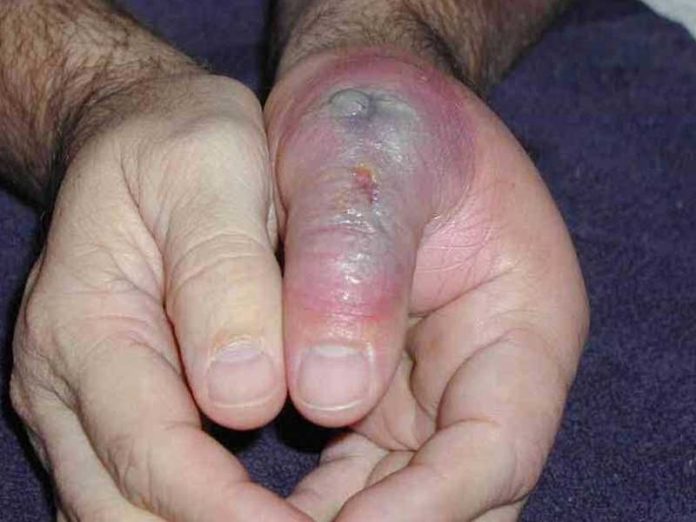The initial contact of a bite may be painful. It’s often followed by an allergic reaction to venom deposited into your skin through the animal’s mouth or stinger. The appearance can vary.
Whether you’re in the water, on a mountain trail, or in your backyard, wildlife you encounter have ways of protecting themselves and their territory.
Insects, such as bees, ants, fleas, flies, mosquitoes, and wasps, and arachnids, such as spiders, ticks, and scorpions, may bite or sting if you get close. Most of these animals won’t bother you if you don’t bother them, but knowing what to look for is key.
Most bites and stings trigger nothing more than minor discomfort, but some encounters can be deadly, especially if you have severe allergies to the animal’s venom.
A severe allergic reaction can happen with any bug bite or sting, depending on the person. Venom allergies may cause a dangerous, severe allergic reaction in some people, resulting in swelling, generalized itching, and difficulty breathing.
Prevention is the best medicine, so knowing how to recognize and avoid biting and stinging insects or arachnids is the best way to stay safe.
The animals you should recognize and understand depend very much on where you live or where you’re visiting. Different regions of the United States are home to many of these creatures.
The season also matters. For example, mosquitoes, stinging bees, and wasps tend to come out in full force during the summer.
Pictures of different bites and stings
The form a bite takes depends on what type of animal bit you. Take a look at the photos below to help identify which animal may have caused your bug bite.
Mosquito bites
A mosquito bite is a small, round, puffy bump that appears soon after you’ve been bitten.
The bump will become red, hard, swollen, and itchy.
You may have multiple bites in the same area.
Fire ant stings
Fire ants are small, aggressive, red or black venomous ants that bite and then deliver painful stings.
Stings appear as swollen red spots that develop a blister on top.
Stings burn, itch, and last up to a week.
Flea bites
Flea bites are usually located in clusters on the lower legs and feet.
The itchy, red bumps are surrounded by a red halo.
Symptoms begin immediately after you’re bitten.
Bedbug bites
The itchy rash is caused by an allergic reaction to the bedbug bite.
The small rashes have red, swollen areas and dark red centers.
Bites may appear in a line or grouped together, usually on areas of the body not covered by clothing, such as the hands, neck, or feet.
There may be very itchy blisters or hives at the bite site.
Fly bites
Painful, itchy rashes are caused by an inflammatory reaction at the site of the fly bite.
Though usually harmless, they may lead to severe allergic reactions or spread insect-borne diseases.
Take precautions when traveling to endemic countries by wearing long-sleeve shirts and pants and by using bug spray.
Lice bites
Head lice, pubic lice (“crabs”), and body lice are different species of parasitic lice that affect humans.
They feed on blood and cause an itchy immune reaction at the site of their bites.
Adult lice are gray/tan six-legged insects about the size of a tiny sesame seed.
Nits (eggs) and nymphs (baby lice) can only be seen as very tiny specks that may look like dandruff.
Chigger bites
Painful, itchy rashes may be caused by an immune response to the bites of tiny mite larvae.
Bites appear as welts, blisters, pimples, or hives.
Bites will generally appear in groups and are extremely itchy.
Chigger bites may be grouped in skin folds or near areas where clothing fits tightly.
Chiggers tend to jump from grass, so bites are usually on legs near the tops of socks.
Tick bites
Bites can cause pain or swelling at the bite area.
They may also lead to a rash, a burning sensation, blisters, or difficulty breathing.
The tick often remains attached to the skin for a long time.
Bites rarely appear in groups.
Ticks can transfer diseases, including Lyme disease, babesiosis, and anaplasmosis.
Read full article on tick bites.
Scabies
Symptoms caused by scabies mites may take 4 to 6 weeks to appear.
The extremely itchy rash may be pimply, made up of tiny blisters, or scaly.
They may cause raised, white, or flesh-toned lines.
This condition is considered a medical emergency, and 911 or local emergency services should be contacted. Urgent care may be required.
Most spiders don’t pose a threat to humans, and in such cases, their bites are harmless or mildly irritating like a bee sting.
Dangerous spiders include the brown recluse, black widow, funnel web spider (Australia), and wandering spider (South America).
A single raised papule, pustule, or wheal may appear at the site of the bite followed by redness and tenderness.
The bite will appear as two small puncture marks.
Severe allergic reactions to a spider bite may require medical attention.
Brown recluse spider bitesThis is a shy, brown- or tan-colored spider with a violin-shaped patch and six paired eyes, two in the front and two sets of two on either side of the head.
It likes to hide in quiet, dark places like closets and bookshelves and is native to the South and South Central regions of the United States.
Nonaggressive, it will only bite humans if it’s being crushed between skin and a hard surface.
Redness appears with a central, white blister at the site of the bite.
Moderate to severe pain and itching at the site of the bite occurs 2 to 8 hours after the spider has injected its venom.
Rare complications include fever, body aches, nausea, vomiting, hemolytic anemia, rhabdomyolysis, and kidney failure.
Black widow spider biteThis condition is considered a medical emergency, and 911 or local emergency services should be contacted. Urgent care may be required.
This spider is plump, black, and shiny, with an hourglass-shaped red mark on its abdomen.
It’s nonaggressive and will only bite if it’s being crushed.
Bites cause muscle pain and spasms in the arms, legs, abdomen, and back.
Tremor, sweating, weakness, chills, nausea, vomiting, and headache are other symptoms.
The bite area is red with a white center.
Hobo spider biteThis
The venom of this common household spider isn’t considered toxic to humans.
Bites are generally harmless and cause only minor pain, swelling, and sometimes muscle twitches.
A single red area appears with a tender central nodule.
Itching, burning, or stinging may occur at the site of the bite.
Wolf spider biteThis
This large (up to 2 inches long), fuzzy, gray/brown spider is native to many parts of the United States.
Nonaggressive, it will bite if it feels threatened.
A tender, itchy red bump appears that heals in 7 to 10 days.
Horsefly bites
These large (1-inch long) blood-sucking flies are most active in the daylight hours.
An instant, sharp burning sensation occurs when a horsefly bites.
Itchiness, redness, swelling, and bruising may also occur at the bite location.
Bee stings
Pain, redness, swelling, or itching occurs at the site of the sting.
A white spot appears where the stinger punctured the skin.
Unlike bumblebees and carpenter bees, honeybees can only sting once due to their barbed stinger that can remain in the skin.
Yellow jacket stings
These thin wasps have black and yellow stripes and long dark wings.
Aggressive, a yellow jacket may sting multiple times.
Swelling, tenderness, itchiness, or redness may occur near the area that’s been stung.
Wasp stings
Sharp pain, redness, swelling, and itching or burning occurs at the sting site.
A raised welt appears around the sting site.
Wasps can be aggressive and are capable of stinging multiple times.
Scorpion stings
Scorpions are eight-legged arachnids with large pincers and long, segmented, stinger-tipped tails carried in a forward curve over their backs.
Many species with variable levels of toxicity can be found all over the world.
Intense pain, tingling, numbness, and swelling occur around the sting.
Rare symptoms include breathing difficulties, muscle twitching, drooling, sweating, nausea, vomiting, an increased heart rate, restlessness, and excitability.
Severe symptoms are more likely in infants and children than adults.Puss caterpillar stings
Puss caterpillar stings
Puss caterpillars may also be known as asp caterpillars, fire caterpillars, woolly slugs, or opossum bugs, and are the larvae of the flannel moth.
They have venomous barbs on their bodies.
They typically reside in the Southeast United States but have been found as far west as Florida and Texas.
A string can cause skin irritation and itchiness, severe pain, and headache.
Kissing bug bites
Triatomine bugs, also called kissing bugs, tend to bite people on the face or near the mouth.
These bugs tend to reside in Mexico, Central America, South America, and parts of the United States.
They carry a parasite called Trypanosoma cruzi and can T. cruzi infection and Chagas disease.
While there are different varieties of kissing bugs, they typically have a cone-shaped head and a long, oval-shaped body with antennae and six legs. They can be light brown to black in color and may have yellow, red, or tan markings.
Bite reactions may include mild itching, redness, and swelling. With a T. cruzi infection, a small hard area may form at the bite site.
Deer fly bites
Deer flies have small, round heads, brownish-black bands on their wings, and gold or green eyes.
Their bites can be painful and cause bumps or welts.
Their bites can sometimes cause a rare bacterial disease known as rabbit fever (tularemia) that may cause skin ulcers, fever, and headache.


























